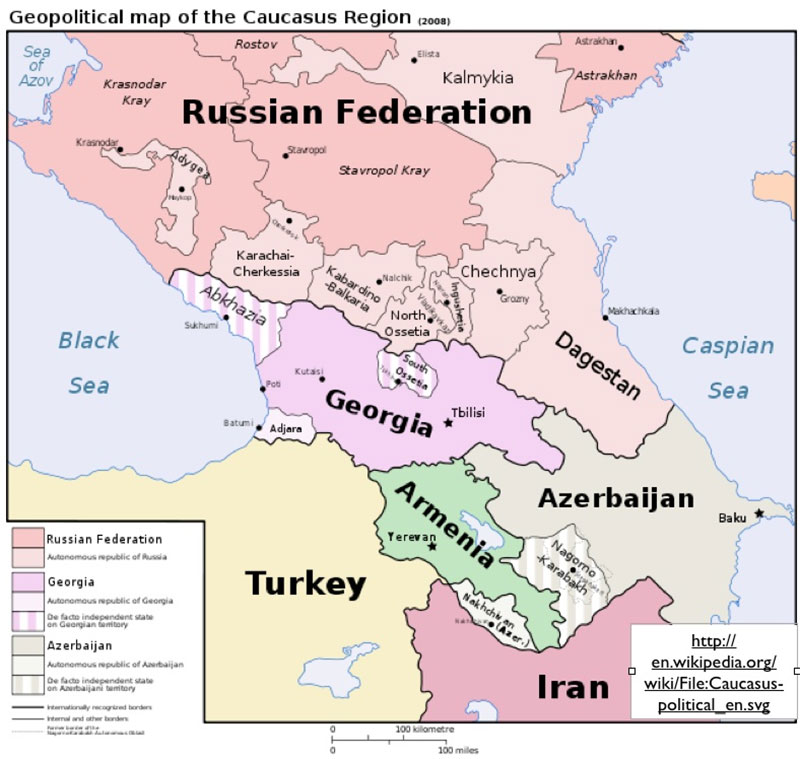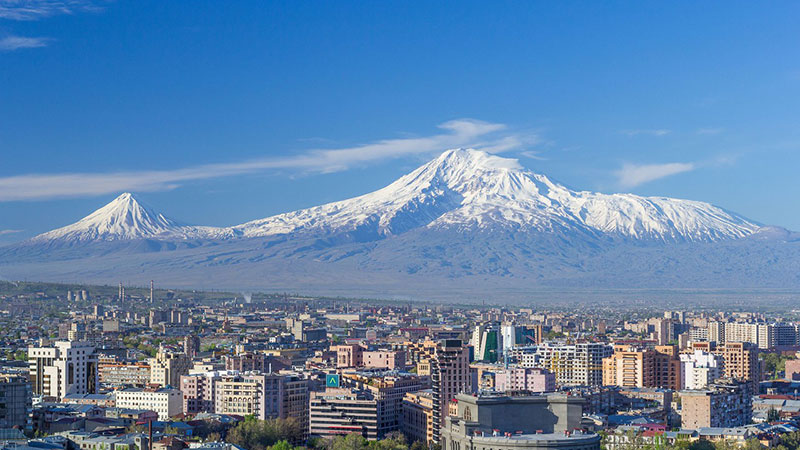Georgia, Armenia, and Azerbaijan

The Caucasus is the mountainous region between the Black Sea on its west and the Caspian Sea on its east. The Caucasus Mountain range is generally considered the divide between Europe and Asia in the region. The Caucasus is bound on the north by the southwestern part of the Russian Federation, on the west by eastern Turkey, and the south by northern Iran. Its is not far from Ukraine which shares the northern Black Sea coast with the Russian Federation.
The independent Caucasus nations are generally considered to be Georgia, Armenia, and Azerbaijan. However, nine governmental divisions of the Russian Federation are also considered part of the Caucasus. The most significant of these for this brief are Chechnya and North Ossetia-Alania.
It should be noted that Georgia, Armenia, and Azerbaijan are all former Soviet Socialist Republics, part of the Soviet Union until the breakup of the USSR in 1991.
The Republic of South Ossetia-Alania is considered by Georgia to be a region of Georgia, but it is majority Ossetian and is recognized by Russia as an independent republic. The Republic of North Ossetia-Alana is part of the Russian Federation.
Georgia is a unitary parliamentary republic. It had a population of 3.9 million in 2024. Native Georgians make up 87 percent of the population. The largest minorities are Azeris and Armenians. Eighty-seven percent of the population is Christian, and Georgian Orthodox believers predominate with 83 percent of the population. About 11 percent are Muslim. The native language is Georgian, but many also speak Russian. The 2025 GDP (PPP) for Georgia was $114 billion, per capita about $30,000. PPP adjusts for the cost of living, which ranks Georgia 70 of over 200 nations. Georgia ranks 97 among 207 exporting nations. Its major export is copper. The capital of Georgia is Tbilisi, population 1.3 million. Georgia is on the eastern coast of the Black Sea, which borders Russia, Ukraine and Turkey. Georgia also has a northern border with the Russian Federation and borders Armenia and Turkey to the south and Azerbaijan to the southeast.
At the early April 2008 NATO Summit in Bucharest, Romania, George W. Bush and NATO declared that Ukraine and Georgia should be part of NATO. There was a brief war in August over Russia’s backing of South Ossetian separatists. Russia was not the initial military aggressor but won very quickly and recognized South Ossetia as independent. NATO members generally did not recognize South Ossetian independence, but the people of the Republic of South Ossetia-Alana are 90 percent Ossetian ethnics and not Georgian. They are de facto an independent republic and ally of the Russian Federation. The Ossetians are descendants of the ancient Scythians and Alans. They speak an Iranian language and are predominantly Orthodox Christians.
In March 2023, the Georgia Parliament passed the first reading of a Law on Transparency of Foreign Influence. This would require any NGO (non-governmental organization) that was more than 20 percent funded by foreign sources to register as “agents of foreign influence.” At the time, there were 25,000 NGOs in Georgia that primarily operated to influence Georgia government. More than 90 percent were funded by foreign sources. These included many typically liberal-left influences like George Soros’s many branches of the Open Society Foundation and the National Endowment for Democracy as well as those related to the US State Department, CIA, USAID, British MI6, and other foreign influences whose purposes are exploitive rather than helpful to Georgia
The European Union, the US, UK, France, and other Western nations funding NGOs to influence Georgia government strongly opposed the bill and organized street demonstrations against it, threatening to bring the government down. They also brought numerous threats of economic and political sanctions against Georgia to stop the bill. The bill was modeled after the Russian law to keep foreign financing and influence out of elections. For example, Alexei Navalny was disqualified from the 2018 Russian Presidential Election because there was strong evidence he was financed by British MI6 and probably other foreign intelligence agencies. Moreover, in any case, his approval ratings averaged less than 14 percent. He was not the golden liberal candidate the Western media made him to be.
In the end, the Georgia Dream Party, under the leadership of Prime Minister Irakli Kobakhidze and the Georgia Parliament stood strong against US, UK, French, and European Union threats and the law became effective. Illegal foreign funding of US Presidential, Senate, and House Elections are a significant threat to the integrity of US elections and honest Constitutional government. The US needs a Law on Transparency of Foreign Influence—particularly financing, bribery, and blackmail.
In addition to all this, Ukrainian President Zelensky, with American and British backing, tried to persuade Georgia to become a second front against the Russians in the Ukraine proxy war against Russia. Georgia firmly declined.
The Republic of Armenia is bordered on the west by Turkey, on the north by Georgia, and on the east by Azerbaijan. A small part of it borders on Iran. Its 2025 population is 3.1 million. The population is over 98 percent Armenian and 97 percent Christian. Over 95 percent of the population identifies with the Armenian Apostolic Church. In 301 AD, the Kingdom of Armenia became the first nation in the world to adopt Christianity as its official religion. Just over one percent of the population are ethnic and religious Yazidis. The Armenian language is a single branch of the greater Indo-European group of languages. The estimated GDP PPP for Armenia is $74 billion, per capita $25,000, ranking 78 among nations. It ranks 93 among exporters. Copper is its largest export. The Capital of Armenia is Yerevan with a population of 1.1 million. The 16,854-feet snow-capped Mount Ararat of Noah’s Ark and Biblical tradition can be seen 26 miles.

SSE from Yerevan. Parts of the city, whose elevation ranges from 2800 to 4500-feet, have been inhabited since 3300 BC.
Armenia has the same problem with foreign NGO influences over its government. Resistance has not reached the level in Georgia. The degree of pressure put on Georgia was a deterrent to passing its own law unless circumstances change. BRICS is a developing alternative to the type of bullying Georgia has endured.
Azerbaijan had a population of 10.4 million in 2022. Ninety-five percent of the population are native Azeris, and 97 percent are Muslims. About 60 percent are Shia Muslims. GDP (PPP) in 2024 was $272 billion with per capita just over $26,000, ranking 78 among nations. Azerbaijan ranks 79 in exports. The major export is petroleum. The Azeri language is in the Turkish language group. The Azerbaijan name, however, is of Persian origin. Indeed, Azerbaijan was once simply referred to as northwestern Iran.
The capital of Azerbaijan is Baku with over 2.3 million people. It is situated on the western coast of the Caspian Sea and is the largest city on the Caspian Sea and of the Caucasus. Its elevation is 93 feet below sea-level. In 1970, Baku was 28 percent Russian, but that is less than 3 percent now. In 1970 the predominantly Christian Armenian population was over 16 percent, about 207,000, but in January 1990, they were the subject to a pogrom of massacre and expulsion. There are very few known to live there now. The number of Jews there in 1970 was 30,000. The number there now is negligible. The Russian population in Baku, mostly Orthodox Christians, fell by 165,000 during the same period. The total expulsions and massacres of Christians and Jews totaled about 300,000. Yet the Azerbaijan nation today is by some considered the most secular Muslim nation in the world.
On August 8, President Trump successfully brokered a peace agreement between Azerbaijan and Georgia that would increase bilateral economic benefits for both countries and normalize diplomatic relations. Since 1988, there had been guerilla warfare between the two nations over the Nagorno-Karabakh region of western Azerbaijan, which was about 67 percent Armenian. In 1988, Soviet Armenia succeeded in having a referendum to transfer Nagorno-Karabakh to Soviet Armenia. Soviet Azerbaijan leaders took violent exception to this and began a series of pogroms against Armenians across all of Azerbaijan. In the military conflict between the Armenian and Azeri armies about 44,000 died between 1988 and 2022. Under the pressure of Azeri ethnic cleansing, most of the 100, 000 Armenians in Nagorno-Karabakh fled to Armenia.
One aspect of the peace agreement is the resolution of controversy over a proposed land route connecting mainland Azerbaijan to its Nakhichevan exclave through Armenian territory. Azerbaijan President Ilham Aliyev seems to be pressing for more authority over the roadway than many Armenians are comfortable with. President Trump has proposed that the US could administer the road.
While Armenian Prime Minister Nikol Pashinyan is comfortable with Armenian compromises made, many of his constituents have reservations. This is especially true of the huge Armenian diaspora. There are more than 1.0 million Americans of Armenian ancestry and over 2.0 million in Russia. Much of this discomfort goes back to the Armenian Genocide of 2015-2017 in the Ottoman Empire (Turkey) in which about 1.5 Armenian Christians were slaughtered. Many of the Armenian diaspora are descended from survivors that fled the Ottoman Empire at that time.
Moscow is uneasy with Trump’s peace agreement because they consider both Armenia and Azerbaijan in their sphere of influence. Moscow was probably caught off guard because Azeri President Ilham Aliyev’s father Heydar Aliyev was a Lt. General in the Russian KGB before he became President of Azerbaijan from 1993 to 2003.
One of the Russian Federation Republics north of Georgia is Chechnya, population 1.5 million, which is about 95 percent Sunni Muslim. Although they fought two terroristic wars against the Russian Federation, since 2007 under the rule of Ramzan Kadyrov, who is also a Lt. General in the Russian Army, they have become Russian and Putin loyalists. The Chechens have been strong supporters of the Russian intrusion into Ukraine and have supplied many military specialist units to the Russian Army in Ukraine. However, there are Chechen separatist units in the Ukrainian Army. The Chechen language is in the Caucasus group, but many Chechens speak Russian as well. In 1970, the Russian population was about 36 percent, but it has dwindled to slightly more than one percent. The capital of Chechnya is Grozny, population 330,000.
The Russian Federation population in January 2025 was 146 million. Only 72 percent are ethnic Russians. The total European is 81 percent. A Pew Research Center poll in 2020 found that 70 percent of Russians identify as Christians. This has grown tremendously since the fall of the Soviet Union and is now higher than the American percentage identifying as Christians. The vast majority of Russians Christians are associated with the Russian Orthodox Church. There is an unusually strong connection between being Russian and being Russian Orthodox. About 7 percent of Russians are Muslims. These Muslims often also have a strong identity with being Russian.









 Mike Scruggs is the author of two books: The Un-Civil War: Shattering the Historical Myths; and Lessons from the Vietnam War: Truths the Media Never Told You, and over 600 articles on military history, national security, intelligent design, genealogical genetics, immigration, current political affairs, Islam, and the Middle East.
Mike Scruggs is the author of two books: The Un-Civil War: Shattering the Historical Myths; and Lessons from the Vietnam War: Truths the Media Never Told You, and over 600 articles on military history, national security, intelligent design, genealogical genetics, immigration, current political affairs, Islam, and the Middle East. 


